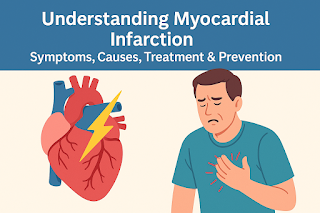Understanding Myocardial Infarction: Symptoms, Causes, Treatment & Prevention
Myocardial infarction, commonly known as a heart attack, is a serious medical condition that occurs when blood flow to the heart muscle is blocked. Without immediate treatment, this can result in severe damage or death of the heart muscle. In this detailed guide, we will cover the symptoms, causes, diagnosis, treatment options, and prevention strategies of myocardial infarction, particularly relevant to readers in the USA.
Table of Contents
- What is Myocardial Infarction?
- Signs and Symptoms
- Causes and Risk Factors
- Diagnosis
- Treatment Options
- Recovery and Rehabilitation
- Prevention Tips
- Lifestyle and Diet
- Helpful Products (Affiliate)
- Related Articles
- FAQs
What is Myocardial Infarction?
A myocardial infarction happens when one or more coronary arteries become blocked, often by a blood clot or a buildup of plaque. The lack of oxygenated blood to the heart can lead to permanent tissue damage if not treated quickly.
Signs and Symptoms
- Chest pain or discomfort
- Shortness of breath
- Nausea or vomiting
- Cold sweat
- Fatigue
- Pain in arms, neck, jaw, or back
Causes and Risk Factors
Common causes include atherosclerosis (plaque buildup), high blood pressure, smoking, diabetes, obesity, and a sedentary lifestyle. Family history and age (men over 45 and women over 55) also increase risk.
Diagnosis
Doctors use ECGs (electrocardiograms), blood tests (troponin levels), echocardiograms, and coronary angiography to diagnose heart attacks. Early detection is crucial for minimizing damage.
Treatment Options
Immediate treatments include:
- Aspirin to thin blood
- Thrombolytic therapy
- Angioplasty and stenting
- Coronary artery bypass grafting (CABG)
Medications such as beta-blockers, ACE inhibitors, statins, and antiplatelet drugs are used for long-term management.
Recovery and Rehabilitation
Cardiac rehabilitation programs offer supervised exercise, lifestyle education, and counseling. Most patients recover within 6–12 weeks with proper support and medical care.
Prevention Tips
- Eat a heart-healthy diet rich in fruits, vegetables, and whole grains
- Exercise at least 30 minutes a day
- Quit smoking
- Maintain a healthy weight
- Control blood pressure, cholesterol, and diabetes
Lifestyle and Diet
Follow the Mediterranean or DASH diet. Include foods like salmon, oats, berries, olive oil, nuts, and leafy greens. Limit red meat, sugar, and processed foods.
Helpful Products (Affiliate Links)
- Omron Blood Pressure Monitor
- Nature Made Cholesterol Support
- Heart-Healthy Cookbook for Beginners
- Fish Oil Omega-3 Supplement
- CoQ10 Supplement
Related Articles (Internal Links)
- Coronary Artery Disease: Complete Guide
- Treating Congestive Heart Failure
- Managing Atrial Fibrillation Naturally
- Hypertension: Diet & Lifestyle Tips
Frequently Asked Questions (FAQ)
1. What are the early warning signs of a heart attack?
Early signs include chest pain, fatigue, dizziness, nausea, and shortness of breath. Women may experience more subtle symptoms like jaw or back pain.
2. Can myocardial infarction be reversed?
The damage from a heart attack cannot be fully reversed, but lifestyle changes and medications can help prevent further issues.
3. How long does it take to recover from a heart attack?
Most people recover within 6 to 12 weeks with cardiac rehabilitation and medical care.
4. Is heart attack preventable?
Yes, with a healthy lifestyle, proper diet, exercise, and regular checkups, heart attacks can often be prevented.
Disclaimer: This article is for informational purposes only. Consult a healthcare professional for medical advice and treatment options.
Published on Life Glow Journal | Updated July 2025

Post a Comment